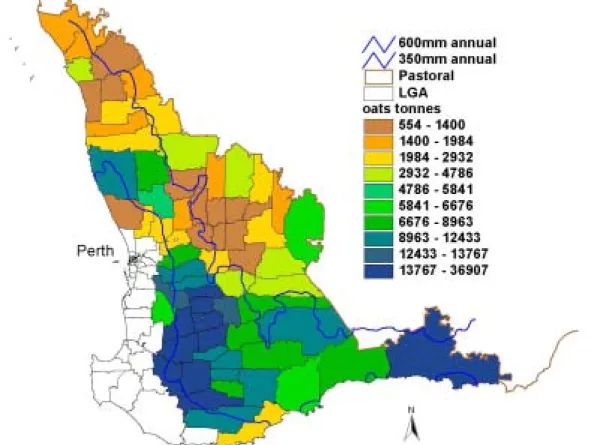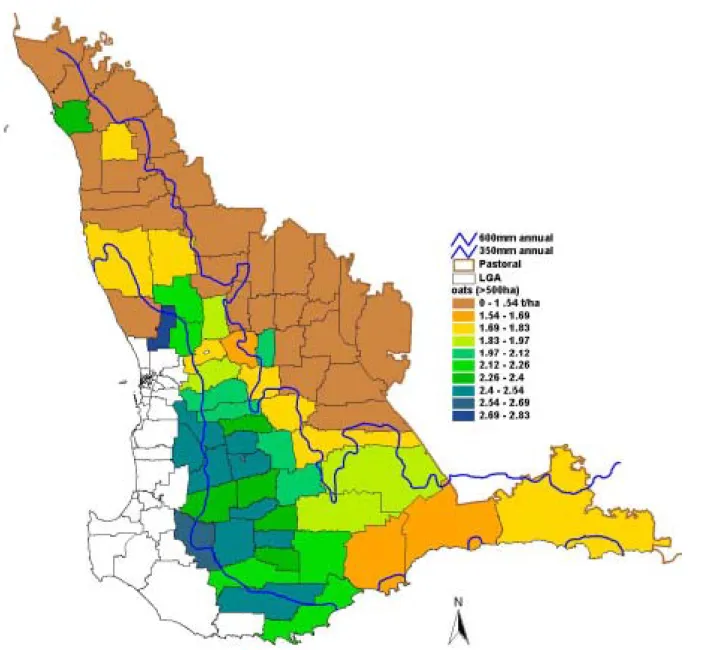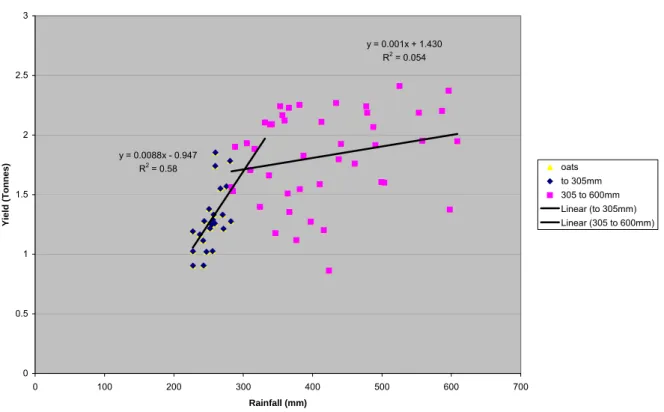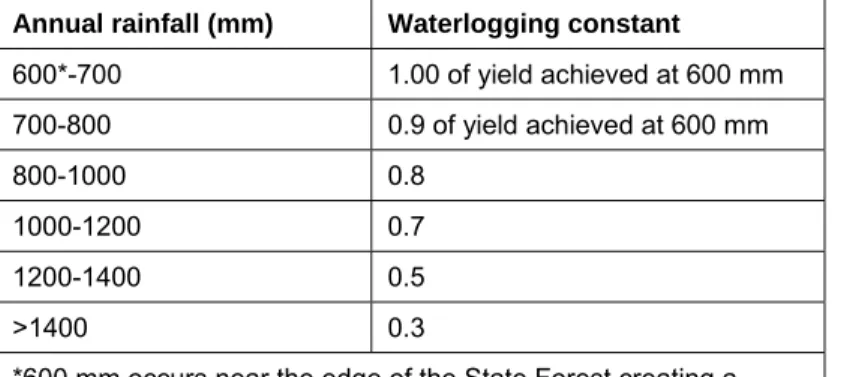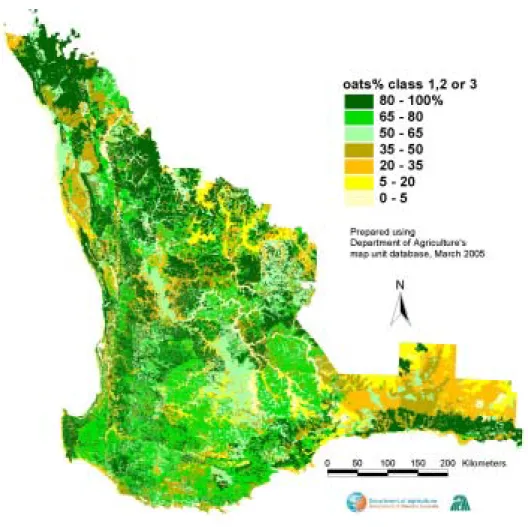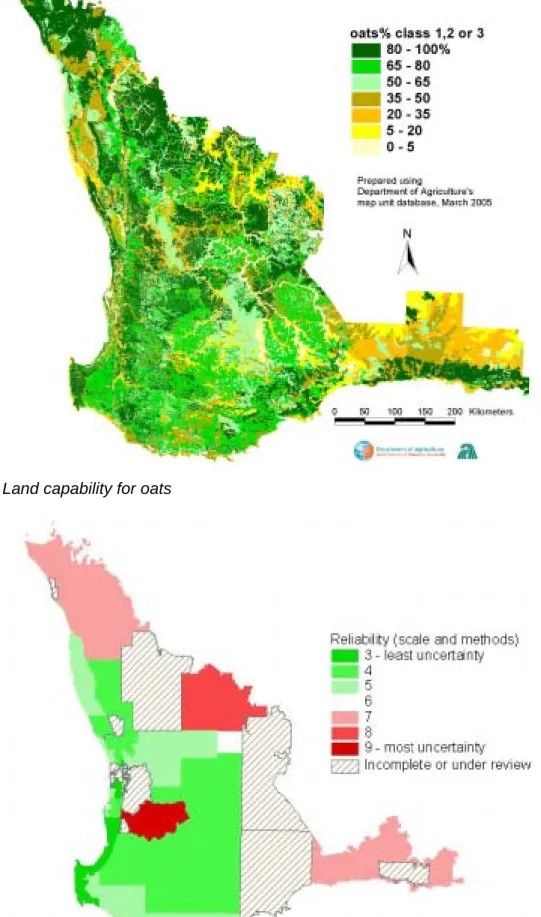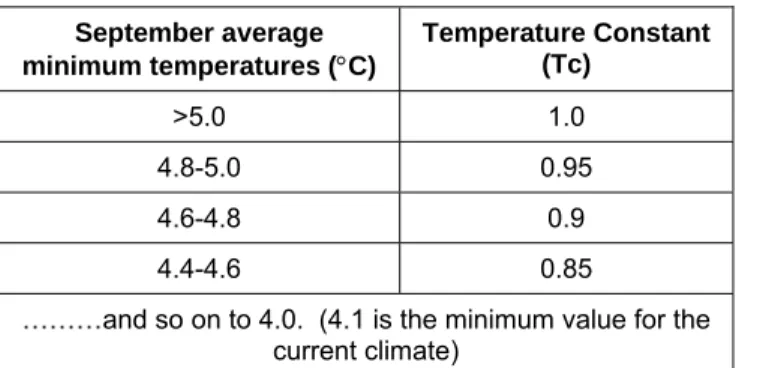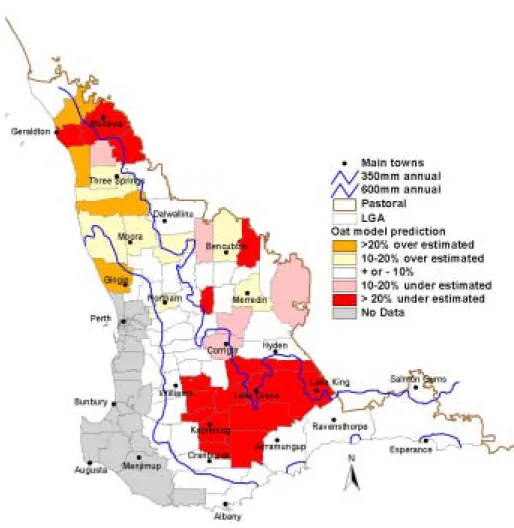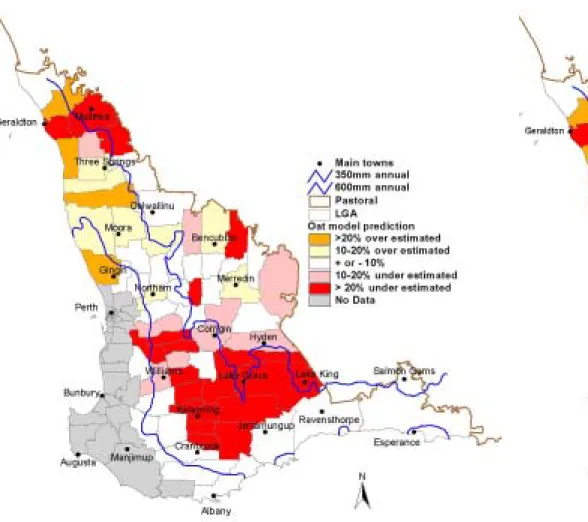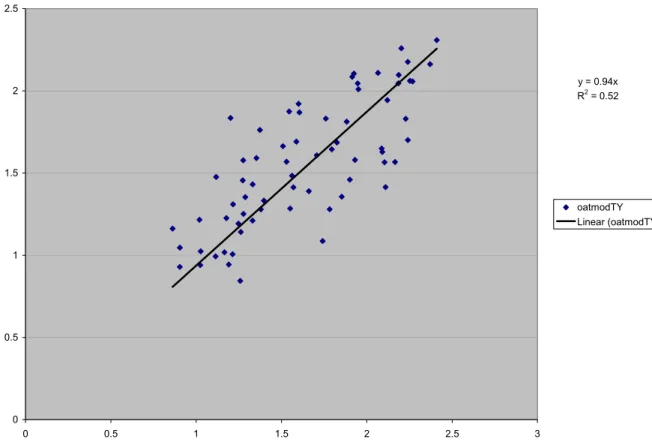Resource management technical reports Natural resources research
2006
Potential impacts of climate change on agricultural land use Potential impacts of climate change on agricultural land use suitability : oats
suitability : oats
Dennis Van Gool Luke Vernon
Follow this and additional works at: https://researchlibrary.agric.wa.gov.au/rmtr
Recommended Citation Recommended Citation
Van Gool, D, and Vernon, L. (2006), Potential impacts of climate change on agricultural land use suitability : oats. Department of Primary Industries and Regional Development, Western Australia, Perth. Report 304.
This report is brought to you for free and open access by the Natural resources research at Digital Library. It has been accepted for inclusion in Resource management technical reports by an authorized administrator of Digital Library. For more information, please contact [email protected].
RESOURCE MANAGEMENT
CHANGE ON AGRICULTURAL LAND USE SUITABILITY :
O ATS
Luke Vernon and Dennis van Gool
March 2006
Resource Management Technical Report 304
Potential impacts of climate change on agricultural land use suitability:
Oats
Luke Vernon and Dennis van Gool
March 2006
Disclaimer:
The Chief Executive Officer of the Department of Agriculture and the State of Western Australia accept no liability whatsoever by reason of negligence or otherwise arising from the use or release of this information or any part of it.
State of Western Australia, 2006
Summary
A relatively simple model was developed to generate climate change scenarios for a variety of agricultural crops. The model was only partially validated against real data, hence it is best used as a decision support system that allows people with crop, land resource and climate knowledge to determine potential impacts of climate change on crop growth and production.
Land use capability data and climate information for the agricultural zone of Western
Australia were combined with a modified French and Schultz equation to produce a potential yield map for oats. Another yield map was then produced for 2050 based on SRES marker scenario A2, CSIRO mark II, which is considered a good model for the South-West of WA.
The area suitable for oats may decrease in the future over an extensive area encompassing much of the eastern, central, southern and south-eastern wheatbelt mainly due to lower rainfall. LGAs which will experience a large reduction in potential yield include Lake Grace, Gnowangerup and Wickepin (≥1,000 tonnes reduction). It is debatable whether adaptation by growers can completely overcome this reduced potential.
Climate change in WA may result in relatively large reductions for (>30 per cent) in potential oat yield for a small area in the northern agricultural region (around Mullewa) by 2050 due to reduced rainfall and higher maximum temperatures. However, current oat yield is not particularly high in the northern regions.
The CSIRO model predicts a small increase in both maximum and minimum temperatures of around 0.8 degrees Celsius. Both the 2050 temperature prediction and crop response to temperature are uncertain. High temperatures will reduce soil moisture, change disease risk and directly affect growth. We believe a high temperature effect is likely, though the amount of increase and the effect on oat yield are uncertain. It is possible that the temperature effect on oat growth may be offset by increased CO2 levels, but this is not considered in our model.
There is a large area where little change is anticipated in the west of the agricultural zone.
However within this region it is likely that low-lying areas perform better as reduced rainfall results in less waterlogging, but drier areas are likely to lose some production.
Overall, this modelling found that 39 per cent of the agricultural zone may experience a decrease in yield potential greater than 10 per cent as a result of climate change. The actual reduction will be less as farmers adapt by altering their planting strategies and changing cultivars.
The model is independent of economic analysis. Our use of the term ‘yield potential’ is indicative, as farmer adaptation occurs anyway and it is difficult to predict the degree of flexibility in this adaptation. This decision support system shows areas of risk such as Lake Grace, where the capacity to adapt may be strained and identifies the best places to grow oats in 2050. Examples of adaptation include the development of new cultivars, such as short season varieties, improvements in management or alternative crops.
Contents
Introduction ... 5
Climatic requirements and influences ... 6
Soil requirements and influences ... 6
Model development ... 6
Materials and methods... 7
The data ... 7
Software ... 7
Method ... 7
Climate change ... 17
Model assumptions... 18
Mean values and the French and Schultz equation ... 18
Temperature-related assumptions ... 18
Results... 20
Discussion ... 24
Climate change predictions ... 25
Model improvements ... 25
Economic implications... 25
Future opportunities ... 28
Conclusion ... 29
References ... 30
Appendix 1: Soil conditions affecting oats... 33
Appendix 2: Oats capability and land qualities... 34
Appendix 3: Selection of temperature limitations ... 36
Acknowledgements
The assistance and helpful comments of Blakely Paynter is gratefully acknowledged.
Funding for this work was provided by the Australian Greenhouse Office.
Introduction
Oats (Avena sativa) is the third most grown cereal crop in Western Australia. In 2001-02 it was planted to 287,000 hectares and yielded 557,000 tonnes (ABS 2005). In the same period the national gross value of oats for grain was $251 million (ABS 2005). Oats are grown in all agroclimatic zones of WA (Anderson and Moore 1998) shown in Figure 1. They are considered one of the most frost tolerant cereals (McDonald 2000).
Figure 1: Average total oat production (tonnes) for each local government authority 1995-99 based on CBH grain receivals
Oat grain produced in WA is used for either human consumption or stock feed. The Grain Pool of Western Australia distinguishes two grades, milling and feed (Garlinge 2005).
Climate variability presents a significant challenge to cropping. Records show that rainfall has declined in the South-West, undergoing a sharp and sudden decrease since the 1970s (IOCI 2002). Day and night-time temperatures, particularly in winter and autumn, have increased gradually over the past 50 years. Although climate is not static even in the absence of human influence, the changes experienced do not appear to have been caused exclusively by natural climate variability (Sturman and Tapper 1996, IOCI 2002).
In order for the cropping industry to adapt to future variability, it is important to identify potential climate change and its impacts. This study aimed to assess potential climate change in the agricultural zone and identify the impacts these may have on oat suitability and growth. It also aimed to identify areas where future management and research efforts may be focused.
Climatic requirements and influences
Oats are slightly more suitable to higher rainfall zones than other cereals due to tolerance of mild waterlogging, the fungal disease take-all, and less susceptible to the same disease strains as other cereals (Littlewood et al. 2002). Oats are also considered one of the most frost tolerant cereals (Littlewood et al. 2002), but are still susceptible during early growth phases and at anthesis, but less so than other cereals (Anderson and Moore 1998).
The optimum growing temperature is around 16-20°C (FAO 1996), although studies have shown slight variation, depending on growth stage. Radford and Key (1993) found that the optimum temperature for maximum mesocotyl + coleoptile length was 15°C, and Sorrells and Simons (1992) reported an optimum of 13-19°C for high grain and straw yields. Hellewell et al. (1996) found that grain yield increased with decreasing temperature down to 15°C. In this study there were no temperature treatments below 15°C, consequently values for optimum temperature could not be concluded. These results supported findings by Buras (1982, in Sorrels and Simons 1992) where the highest grain yields in four oat cultivars were obtained from 9-15°C. As temperatures were increased above 15°C, yields began to decline.
Oats are susceptible to high temperatures (Radford and Key 1993, Anderson and Moore 1998). At anthesis these increase the number of empty spikelets, and during grain
development cause premature ripening and lower grain weights (Brown 1975, in Anderson and Moore 1998).
Soil requirements and influences
Oats are grown on a wide range of soils, and can tolerate acidity, waterlogging and poorly prepared seedbeds more than the other cereals (Anderson and Moore 1998). In general, good yields are achieved on soils which are well drained with no hardpans or surface crusting (Anderson and Moore 1998).
There is little published data about waterlogging tolerance (Setter and Waters 2003).
However, oats are the most tolerant cereal at the seedling stage, and it is often supposed that they have a higher overall tolerance to waterlogging than barley and wheat.
Commenting on research by Watson et al. (1976) and Cannell et al. (1985), Setter and Waters (2003) suggested that oats may have one of the greatest abilities of all cereals to recover from waterlogging events.
For further information on soil factors affecting the productivity of oats, refer to the summary in Appendix 1 by Anderson and Moore (1998).
Model development
To estimate yield, the model uses the rainfall-driven French and Schultz (1984) equation, to which adjustments are made to consider land capability, waterlogging and maximum and minimum temperatures. The French and Schultz equation has been accepted as a useful model for grain crops in WA, even though reporting has been informal or anecdotal (e.g.
Tennant 2001, Hall 2002). Some detailed work has been undertaken for grain legumes (Siddique et al. 2001).
The model was first developed in conjunction with Peter White for use with pulses and legumes in WA and was reported by van Gool et al. (2004a,b). When yield predictions seem reasonable, the effects caused by climate change are predicted by re-running the model for a selected 2050 climate scenario.
The model is a good tool for combining complex data and expert knowledge. It bridges the gap between a number of scientific disciplines and several audiences: people involved in
Materials and methods
The data
• Bureau of Meteorology (BoM) climate surfaces for rainfall, maximum temperature and minimum temperature. These are mean daily values for each month for 1961 to 1990 shown on 0.25 x 0.25 degree grid cells (approx. 2.5 km).
• Department of Agriculture’s map unit database and land resource maps to create land capability maps for each crop. Mapping scales range from 1:20,000 to 1:250,000. See Schoknecht et al. (2004) for an overview of soil-landscape mapping methods and outputs and van Gool et al. (2005) for an explanation of land qualities and land capability.
• Ozclim climate scenario (SRES Mark II) available from CSIRO Atmospheric Research which predicts changes in rainfall plus maximum and minimum temperature.
• BoM Patched Point climate data.
• Published and unpublished information about the crops.
• CBH grain bin receivals information for 1995 to 1999 summarised for local government areas prepared by the Farm Business Development Unit, Department of Agriculture, Western Australia.
• Expert and local knowledge.
Software
The mapped information was prepared using Arcview 3.2 and Spatial Analyst. The gridded BoM climate and Ozclim climate change information was matched to the centroid of each soil-landscape map unit by a unique identifier. Only matching grid cells were used and no attempt was made to summarise further. The information was then exported to an Access 97 database, where all the yield calculations were done. The information was then exported back to Arcview for display, but any other GIS package could be used.
Method
Yield
Initial estimates of water use efficiency were derived from the literature. After a review of this study by staff from the Australian Greenhouse Office it was requested that this information be scaled to real data. We had mean values for yields based on CBH grain receivals (Figure 2) and corresponding Bureau of Meteorology rainfall records for 1995-99 readily available.
Grain receival figures give more conservative estimates of water use efficiency than others reported (e.g. French and Schultz 1984, Tennant 2001). The yields represent averages achievable in the south west agricultural region in 1999. It should be noted that oat yields are less reliable than other cereals because a lot of oaten hay is sold and used on the farm.
For this report no attempt was made to estimate the amount of hay produced. It should also be noted that the mean yields are scaled both up and down for good and poor cropping land as indicated by the land capability which considers both the soil type and the position in the landscape.
Figure 2: Mean oat yields (tonnes/hectare) 1995-99 based on CBH grain receivals
To analyse the CBH figures, in the interests of simplicity, and because there was insufficient data to warrant using a more complex model, the equation was partitioned using two linear regressions of yield and rainfall (Figure 3). For 150-305 mm rainfall the regression line is similar to the French and Schultz (1984) equation and for 305-600 mm there is much lower water use efficiency. The lines were drawn where they best represented the data (the R2 values were maximised). Up to 305 mm there was a very good fit. Beyond 305 mm the data fit poorly. The use of two linear regressions instead of a polynomial equation is generally not condoned, however it is a pragmatic solution for our decision support tool. The ‘x’ intercept of the line from 150 to 305 mm was used to estimate the evaporation water loss (110 mm).
oats
y = 0.0088x - 0.947 R2 = 0.58
y = 0.001x + 1.430 R2 = 0.054
0 0.5 1 1.5 2 2.5 3
0 100 200 300 400 500 600 700
Rainfall (mm)
Yield (Tonnes) oats
to 305mm 305 to 600mm Linear (to 305mm) Linear (305 to 600mm)
Figure 3: Linear regressions on mean oat yields 1995-99 based on CBH grain receivals (scaled to 1999 figures)
Mean yield was estimated using a modified equation of French and Schultz (1984).
Adjustments for excessive rainfall (WAc), soil capability class (LCc), minimum temperature (Mintc), maximum temperature (Maxtc) were added.
[1] (If GR<= 305 mm) MY = WUE1 × (GR – WL) × WAc × LCc × Mintc × Maxtc [2] (If GR> 305 mm) MY = WUE2 × GR + YI × WAc × LCc × Mintc × Maxtc MY = mean yield
WUE1 = water use efficiency which is approximately 8.8 (from CBH grain receivals) WUE2 = water use efficiency which is approximately 1 (from CBH grain receivals) YI = Yield at the intercept of the two regression equations = 1736 kg
GR = growing season rainfall for 1 May to 31 October, plus 20% of rainfall 1 November to 30April (20% accounts for initial soil moisture available to the crop)
WL = water loss
If GR ≥150 mm/yr THEN WL = 110 If GR < 150 mm/yr THEN WL = GR × 0.6 WAc = waterlogging constant (see below) LCc = land capability class constant (see below) Mintc = minimum temperature constant (see below) Maxtc = maximum temperature constant (see below)
Waterlogging constant (WAc)
In this scenario growing season rainfall above 305 mm was approximately where the water use efficiency of oat growth declines dramatically for a variety of reasons. Excess water is removed by run-off or leaches beyond the root zone, and increased disease problems can reduce predicted yields. Waterlogging and increased incidence of disease will result in yield reductions when rainfall becomes very high. In the absence of better data, yield potential
was decreased for increasing rainfall above 600 mm (Table 1). Further data was not sought because of time constraints and because it was felt that it would have only a small impact on our model because 600 mm occurs near the edge of the State Forest which is a distinct physical boundary for the cropping region. (State Forest areas are shown on Figure 13.)
Table 1: Waterlogging constants for adjusting yield potentials for annual rainfall
Annual rainfall (mm) Waterlogging constant
600*-700 1.00 of yield achieved at 600 mm 700-800 0.9 of yield achieved at 600 mm 800-1000 0.8 1000-1200 0.7 1200-1400 0.5
>1400 0.3
*600 mm occurs near the edge of the State Forest creating a distinct physical cropping region boundary.
Land capability constant (LCc)
'Law of the Maximum' (Wallace and Terry 1998) states that a large yield response is possible if there is only a single limiting factor, but as the capability table indicates (Appendix 2), if one limitation is overcome, others soon come into play. This suggests that only when all limiting factors are addressed simultaneously does plant production have a chance of reaching biological potential. For this reason using land capability maps based on many factors for this yield model we believe is superior to models driven from only one or two more readily available, or better understood properties, such as soil water storage or pH. Lower capability means greater constraints for plant growth and reduced yield, hence the average crop yield is scaled using the values listed in Table 2.
Table 2: Land Capability Class constants for adjusting yield potentials on each soil capability class
Land Capability Class Land Capability Class Constant (LCc)
1 1.8 2 1.4
Higher than average yields
3 1.0 Average yields
4 0.6
5 0.4 Lower than average yields
Land capability ratings for oats were based on Anderson and Moore (1998), van Gool, Tille and Moore (2005) and Maschmedt (unpublished), with fine-tuning in consultation with agronomists from the Department of Agriculture. The ratings can be best described as considered judgements taking into account local experience and research data that were available (both published and unpublished).
The development of the ratings involved several iterations. Ratings were fine-tuned until consensus that the maps of land capability provided a good general representation of reality (see Figure 4) in the context of a subjective evaluation of survey quality using the date of publication, survey methods and mapping scale (see Figure 5). See Appendix 2 for the final capability table for oats.
Figure 4: Land capability for oats
Figure 4: Subjective assessment of reliability based on mapping scale and survey methods
Temperature constants (Mint, Maxt)
Maximum and minimum temperatures for oat growth were collated from Ecocrop (FAO 1996) and the Australian software program PlantGro™ (Hackett 1999). These temperature values suggest that oats experience significant yield reductions when temperature exceeds 35°C and may die when they exceed 38°C. At the low temperature extreme, yield is depressed significantly at -5°C and plants normally die at -8°C.
These temperature values were then related to averages of the daily monthly maximum and minimum temperatures on the BoM climate surfaces (see Tables 3 and 4).
Because we are using daily temperatures averaged for an entire month there will be a significant fluctuation around this value, hence the temperatures reported in Tables 3 and 4 may seem higher or lower than expected. Refer to Appendix 3 for how the yield limiting temperature values in Tables 3 and 4 were estimated.
For maximum temperature, the three months August to October were used. During this time there is a fairly linear increase, and more warm days occur in October than August.
For minimum temperature, temperatures of -5°C are rare, but frosts are common in some regions. September was selected because crops are highly vulnerable to frost damage at this time. Our minimum temperature restriction is loosely related to the likelihood of frosts (see Figures A4 and A5 in Appendix 3).
A maximum temperature was selected using a monthly mean temperature about 13°C less than the point at which significant plant stress was thought to occur. For the minimum temperature, the monthly minimum was about 9°C higher than the point at which significant plant stress was thought to occur. Other than FAO (1996) and Hackett (1999), there was little real data to support these selections in WA. However, the model iterations, discussed below, were used to fine-tune the temperature adjustments.
The tables show how yield is decreased as average maximum temperature rises (Table 3) and average minimum temperature falls (Table 4) below the critical levels. See Appendix 3 for further information on selection of temperature limitations using monthly averaged data.
Table 3: Temperature constants for adjusting yield potentials for average maximum temperatures (from August to October)
August to October average
maximum temperatures (°C) Temperature Constant (Tc)
<21.8 1.0 21.8-22 0.95 22-22.2 0.9 22.2-22.4 0.85 22.4-22.6 0.8
……….and so on to 24.8. (24.7 is the maximum value under the 2050 climate scenario.)
Table 4: Temperature constants for adjusting yield potentials for average minimum temperatures (in September)
September average minimum temperatures (°C)
Temperature Constant (Tc)
>5.0 1.0 4.8-5.0 0.95 4.6-4.8 0.9 4.4-4.6 0.85
………and so on to 4.0. (4.1 is the minimum value for the current climate)
Note The initial minimum temperature value was 5.6. This was reduced to 5 in the model iterations.
Model iterations
As described above, considerable effort went into reaching land capability maps that accorded with ‘expert’ opinion. Maps underwent several iterations and results were
discussed until consensus was reached that they were a reasonable representation of reality.
When yield maps have been prepared the results can be verified against actual yield data.
However, this is complicated by huge diversity in trial information, including the methods adopted for the trial, the reporting methods and the lack of detailed climate and soil information at the trial sites. A visual assessment of the mapped areas indicates that the modelled maps show high yields where existing trials yield well and vice versa. Trials should be considered because it would minimise variability due to management and farm
economics. Trial information yields higher than achievable on most operational farms and is not readily available over extensive areas. Early wheat research trials reported by Davidson and Martin (1968) indicate that farm wheat yields for selected sites in WA achieve between 57 and 72 per cent of experimental yields. The model considers a mean yield based on 1995-99 CBH yields (Figure 2) as such data were readily available. Because there is a gradual increase in yield over time the CBH figures are scaled to 1999 yields.
It is instructive to view the comparison of modelled and actual shire yields spatially. Figure 6 shows where the model predictions were out by more than 10 per cent. It was noted that the model underestimated oat yields in several LGAs toward the middle of the map around Corrigin because the minimum temperature restriction was too severe. Figure 7 shows the improvement when the minimum temperature where yield penalties occur is adjusted from 5.6 to 5 degrees. Hyden, Williams, and 5 LGAs north of Williams improve. There was no change in Figure 7 for the >20% underestimates around Katanning and Lake Grace to the south because these underestimates were not directly attributable to temperature. It is possible that there is a temperature response around Mullewa, however the maximum temperature restriction could not be altered or yields begin to increase for Three Springs and Chapman Valley which are already overestimated (see Figure 14 and Table 6 for locations).
.
Figure 6: Areas where the model varies from CBH 1995-99 data by more than ±10%
Figure 7: Areas where the model varies from CBH 1995-99 data by more than ±10% when yield penalties for minimum temperature are adjusted from 5.6 to 5 degrees.
Figure 8a shows yield predicted by the model, averaged for each local government area against CBH yield. Figure 8b shows the yield predicted by the model against ABS crop yield figures for 1983-87 (ABS figures are comparable to CBH figures). A linear regression is not ideal, as CBH yields are not an ideal ‘known’ value but have significant variability. There is uncertainty in assessing which locations deliver to particular storage bins. Also some crops do not go via the storage bins at all. Even if yield figures are reliable there is variation in management, varieties grown, planting times and climate and soil types. The graph indicates the model has a fairly poor predictive ability, which is not surprising given the general assumptions (discussed under Model assumptions). Particular attention is drawn to the assumption that all soils in a local government area are considered. It should be
remembered that:
the model attempts to predict where the productivity of cropping land for oats is likely to change as a result of climate change, irrespective of whether it is being cropped for oats currently (e.g. see Figure 1).
This allows you to predict possible shifts in productive areas. Apart from minor adjustments to the temperature constants, the CBH data is used to scale the information rather than for validating the model.
y = 0.94x R2 = 0.52
0 0.5 1 1.5 2 2.5
0 0.5 1 1.5 2 2.5 3
oatmodTY Linear (oatmodTY)
Figure 8a: Modelled versus actual yield - average value for 1995-99 in tonnes
y = 0.92x R2 = 0.47
0 0.5 1 1.5 2 2.5
0 0.5 1 1.5 2 2.5 3
oatmodTY Linear (oatmodTY)
Figure 8b: Modelled versus actual yield - average value for 1983-87 in tonnes
Climate change
Climate change scenarios to 2050 were generated using OzClim, which is a generator that simplifies the process. OzClim is available from CSIRO Atmospheric Research (email AR- [email protected] or http://www.dar.csiro.au/publications/ozclim.html).
The temperature change scenario was the SRES A2 CSIRO Mark II. OzClim was used to calculate surfaces that show the difference from the base climate (1961-90). The Ozclim values are used to adjust current base climate values (1961-90) which are at 2.5 km resolution. This is preferable to the 25 km resolution surfaces generated from Ozclim directly. The entire model is then simply re-run for the new climate.
Model assumptions
This model/decision support tool assumes:
• Management practices, whether improvements or a result of a response to climate change such as different planting times, do not alter over the course of the scenario
• Carbon dioxide concentrations remain the same. This is important when considering the results, as modelling by Howden et al. (1999) showed that wheat yields would more than likely increase at all sites studied (Geraldton, Wongan Hills and Katanning) under future climate change scenarios with a doubling of current carbon dioxide levels.
• Plant growth responses to temperature extremes or excessive rainfall are generally not linear except over a small portion of the response curve. Tables 2, 3 and 4 show a linear relationship of waterlogging and temperature with growth. This is because the lowest September daily mean temperature is 4.1°C and the highest August to October daily mean is 24.7°C. Most of the agricultural region appears to have only slight temperature limitations and the 50 year climate change scenario climatic adjustments are relatively small. Waterlogging/disease limitations apply after 600 mm, but this occurs mostly in forest/water catchment areas (shown on Figure 13) that are not available for cropping.
The model would need temperature and waterlogging responses checked for other regions, or if climate change was much greater than presently predicted.
• All the soils within a local government area are considered. In reality some soils would simply not be cropped e.g. saltland or bare rock. The maps indicate high and low productivity land and where productive land might be lost as a result of climate change.
Because there is no record of which soils are actually being cropped, validating the model against grain yield records based on local government areas can only be indicative.
Because the model considers all land in a local government area, if there is a large
amount of class 5 land the model would predict reduced yield. This would be misleading if oats is only grown in a portion of the shire where class 1 to 3 land dominates.
• Only grain yields are considered. This is a problem for oats as a significant proportion is retained for hay and for use on the farm. The oat grain receival figures would be less reliable than for barley and wheat.
Mean values and the French and Schultz equation
The model also only deals with average conditions. It does not consider climate extremes (droughts and floods) which are reported to be more frequent with climate change (e.g. IPCC 2001).
The French and Schultz equation is an appropriate tool for dealing with average climate values (e.g. BoM 1961-1990). It is not suitable for looking at crop growth in a single season because it only considers if there is adequate rainfall over the growing season. If the rain falls too early or too late in the season there will be a large effect on crop growth that cannot be predicted. Over a longer time period these seasonal differences are averaged out.
Temperature-related assumptions
• The temperature requirements for different cultivars can vary greatly. However, the model assumes a single cultivar for a given scenario.
• There are interactions between temperature and moisture availability. For example oats will tolerate 38°C if soil moisture is not limiting, and the plant is not under moisture stress.
The temperature/moisture interaction can be built into the model (and has been trialled), but was not used for the scenarios generated for this report.
much higher frost risk in July, which is the coldest. This model uses the September coldest temperatures. Adding temperature criteria for other months to account for critical plant growth periods would be straight forward.
• Frosts can reduce yields by damaging plants, but cooler temperatures are beneficial for consistent grain filling, hence the response to minimum temperature can be difficult to predict.
• When it is warmer oats have short grain filling, hence there is less opportunity to achieve good yields, and any moisture or temperature stresses will reduce yields more than in cooler areas. The model assumes a single cultivar, though a new scenario could be generated for each cultivar if the climatic or soil requirements were known to be significantly different.
• Temperature may not be a direct problem for the plant, but evaporation and evapo- transpiration may dry soils before the crop has finished growing. This was considered when making high temperature selections in the model.
• Higher temperatures are generally correlated with increased numbers of plant pathogens.
This was considered when making high temperature selections in the model.
• Finding relatively detailed climate information for oats suitable for preparing regional summaries using monthly averaged temperature data proved difficult. It is generally accepted that temperature affects growth and yields. However, we are unaware of any regional temperature modelling that has been quantified, hence our initial predictions are largely based on estimates from the literature and field knowledge from oat agronomists.
Model iterations were then used to adjust these values
Results
Changes in potential yield over the 50 year climate scenario due to rainfall only are shown in Figures 9 and 10. The highest current potential yields are in the west of the agricultural zone. Potential yields decrease in 2050 over most of the agricultural zone, particularly in the east and north.
Changes in potential yield due to temperature and rainfall are shown in Figures 11 and 12 with a difference map in Figure 13. These show reductions in potential over most parts of the agricultural zone, except for western areas.
The maps show a relatively large reduction in potential yield in the north of the agricultural zone, and Figure 13 confirms that the region extending north from Dalwallinu experiences a greater than 30 per cent reduction in potential yield, the largest decrease.
There is a large area of no change (±10 per cent) in the western wheatbelt bounded by State Forest.
Just under half of the agricultural area will experience some decrease in potential oat yield.
Some 40 per cent of the land, or 10.8 m ha showed a reduced potential yield of 10 per cent or more. The remaining 15.9 m ha of land did not change (i.e. ±10 per cent). This was the fourth largest decrease predicted for crops studied in this series, behind canola (45 per cent), barley (43 per cent), wheat (42 per cent) shown in Table 5.
Table 5: Area experiencing change in potential yield for crops analysed in this study (van Gool and Vernon 2005, van Gool and Vernon 2006, Vernon and van Gool (2006a,b)
Area of agricultural zone experiencing change of potential yield (%)*
Reduction Barley Canola Lupin Oats Wheat(a) Wheat(b)
Large (>30%) 2 1 0 <1 (0.1) 3 2
Moderate
(20-30%) 4 4 <1 (0.3) 1 3
Small (10-20%) 37 40 27 39 36
32
No change
±10%) 57 55 73 60 58
59 (plus 8%
increase) (a) are the updated values when wheat is re-run using the current model (utilising two linear regressions).
(b) are the values published in van Gool and Vernon 2005. Note this model predicts a small area of yield increase because it assumes yield penalties when growing season rainfall exceeds 400 mm. The current model uses 600 mm.
* Total area of the agriculture region is approximately 26.7 million hectares.
Figure 9: Current potential yield based on rainfall Figure 10: 2050 potential yield based on rainfall
Figure 11: Current potential yield based on rainfall and temperature Figure 12: 2050 potential yield based on rainfall and temperature
Figure 13: Oat yield change over 50-year scenario when current potential yield was greater than a third of the maximum potential yield achieved by the model (708 kg/ha). Note:
the 450 mm isohyet is the optimum growing season rainfall, not the annual contour for oats
Discussion
The small region with a large decrease in potential yield (more than 30 per cent) in the north of the agricultural region (near Mullewa) was due to a combination of reduced rainfall and increased maximum temperatures in 2050.
Temperature change is less reliably predicted by climate scenarios, plus the specific impact of high temperature on oat yield is subject to debate. Further uncertainty is cast by modelling done by Howden et al. (1999), which indicated that under a doubling of CO2 concentrations wheat (hence oat) yields might actually increase with climate change in the future.
It should be noted that in our generic model high temperature effects are estimated based on grain yield, and not dry matter production. High temperatures will reduce soil moisture stores more rapidly, and will increase the likelihood of some diseases, as well as impact directly on oat growth. With temperature, the main effect is a shorter growing season. Development of short season varieties could potentially offset yield reductions more than for a total reduction in rainfall. However, in combination reduced rain and higher temperature will impact on oat growth and farmers ability to adapt to these changes. It is likely that with a temperature increase in the hottest parts of the agricultural region, there will be anything from a negligible effect, to a significant reduction in yield.
The 10-30 per cent decrease in potential yield over a significant portion of the agricultural zone (shown in Figure 13 as light red for 10-20 per cent plus a small portion of bright red for 20-30 per cent), was due predominantly to reduction in rainfall. Reductions to the north of the agricultural zone (around Mullewa) were also due to an increase in the maximum temperature.
There is a large area of no change east of the State Forest. There is speculation that less rainfall in these high rainfall areas will result in less waterlogging and disease, and hence an increase in yields. Stephens (1997) and Stephens and Lyons (1998) indicated a negative impact of waterlogging in higher rainfall areas. However this is not supported by the data we have used to scale our model for this study, particularly the simple linear regressions
(Figure 3). Our model would show a positive impact from reduced rainfall in these regions if our waterlogging constraint occurs at considerably less than 600 mm rainfall. It is possible that the data used lacks the detail required, as it is based on LGA averages. Within an LGA, higher portions of the landscape and well drained soils are likely to experience yield
reductions with decreased rainfall. This could be completely offset by areas that are less well drained which would become less waterlogged and have increased yield. Hence the area of no change is likely to be misleading because within this region there are likely to be farmers that benefit, and farmers that lose out depending on the soils on their farms.
We have assumed a small yield reduction occurs in cold areas due to climate change because of reduced incidence of frosts. With slightly increased temperatures due to climate change yields may go up a little. However, in cooler areas grain filling tends to be more consistent, so yields may actually go down due to increased temperature. It is likely that the net effect of slightly increased minimum temperature is going to be small.
Results showed that there was a significant overall decrease in yield over a large portion of the agricultural zone. This may be significant to oat growers, particularly those in the northern wheatbelt, who would need to (continue to) adapt to climate change more than growers in other regions. Adaptation includes management, but these results may also present some direction for oat breeders for continuing development of new cultivars for this region.
Climate change predictions
We have already mentioned that not considering CO2 change is a major limitation of the model.
The uncertainty surrounding the prediction of future climate change needs to be taken into account when considering the results from this modelling. Indeed, recent studies have highlighted other sources of uncertainty surrounding climate change. Stanhill and Cohen (2001) described the phenomenon of a widespread decrease in solar radiation, termed global dimming, and at first appears to be contrary to the undeniable evidence for increases in temperature during the past four decades. Studies such as these have resulted in much debate among the scientific community about the validity of past climate change predictions and the potential processes and mechanisms causing global warming under global dimming.
Supporting this phenomenon, Roderick and Farquhar (2004) found that, similar to the northern hemisphere, pan evaporation rates in Australia have actually decreased over the last 30 years. Liepert et al. (2004) provided a potential explanation for global warming under a global dimming situation. They concluded that “a radiative imbalance at the surface leads to weaker latent heat and sensible heat fluxes and hence to reductions in evaporation and precipitation despite global warming”.
The lack of suitable temperature information about oats to improve the relationship with the monthly mean climate surfaces certainly affects the credibility of this model. However, we would argue that even with insufficient data the strength of this model is its simplicity. It is a useful decision support tool for predicting likely climate change effects on agricultural crops based on any combination of data, available literature and ‘expert’ opinion. Additionally, as shown in the model iterations, the model can be run several times and matched against available yield data to overcome gross errors in the temperature adjustments.
Model improvements
A better reliability estimate would occur if the model was quantified and calibrated against existing yield information gathered from controlled trials. Preliminary investigation is under way which is collating (initially) pulse trial data over a number of years with adequate information on trial methods and soil types. Funding will dictate how far this work will progress.
The model could be improved by factoring in a ‘confidence’ or ‘reliability’ estimate with each of the inputs (e.g. see Figure 5). It is also worth noting the two predicted yield decreases for wheat in table 5. Even though different equations were used (the 2005 wheat report utilised French and Schulz figures derived from the literature) the areas predicted remained quite similar. This suggests that our updated model gives little extra value for the regional
predictions, particularly when the increased complexity of using the two linear regressions is considered.
We used the model as a decision support tool, and our test was whether the maps reflect reality against expert opinion or local knowledge. Feedback is important to the success of this process and the local credibility of the maps. It may be advantageous to formalise this process further, and investigate how to incorporate uncertainty measures based on the feedback.
The important point to note, is that if expert opinion changes, or there are several likely scenarios these could all be generated fairly readily.
Economic implications
If you have skipped to this section to discover the potential dollar value of the effects of climate change, we believe this has little practical value and would be misleading without a
detailed look at many aspects of oat production – which is beyond the scope of this report. It is a simple task to summarise our modelled change for each local government authority (Figure 14 – see Table 6 for corresponding LGA names) and then calculate a dollar value for lost production. But what does this really tell us? Because there is considerable flexibility for adjustments in management practices, e.g. planting times, row spacing and different oat varieties, the actual change in productivity will be less than predicted by the model. What the map does indicate are those LGAs which are likely to experience the greatest pressures to make adjustments because of climate change.
Lake Grace (No. 131) Gnowangerup (153) and Wickepin (128) have reduced yield potential of 1000 tonnes or more (Table 7). Table 7 also highlights shires where the need for adaptive changes will be high. The LGAs with highest pressure for change, denoted by areas greater than 10% reduction in yield potential, are Dumbleyung (138) 13% and Kulin (126) 11%.
Figure 14 indicates shires that have a reduction of 15 per cent or greater. These include Dowerin (56), Nungarin (58), Kellerberin (66), Bruce rock (74). This means that there is likely to be a major impact of climate change on oat production, however none of these LGAs currently produce many oats (see Figure 2).
Figure 14: Oat yield change for each LGA
Table 6: LGAs and corresponding identification numbers
No. Name No. Name No. Name
26 Northampton (S) 68 Cunderdin (S) 130 Cuballing (S) 30 Mullewa (S) 69 Wanneroo (C) 131 Lake Grace (S) 32 Chapman Valley (S) 70 Northam (S) 132 Ravensthorpe (S) 35 Greenough (S) 71 Swan (S) 133 Waroona (S) 36 Geraldton (C) 73 York (S) 134 Williams (S) 37 Morawa (S) 74 Bruce Rock (S) 135 Narrogin (S) 38 Perenjori (S) 75 Mundaring (S) 137 Harvey (S) 39 Mingenew (S) 76 Narembeen (S) 138 Dumbleyung (S) 40 Irwin (S) 77 Quairading (S) 139 Collie (S) 41 Three Springs (S) 78 Stirling (C) 140 Wagin (S) 42 Carnamah (S) 79 Bayswater (C) 141 West Arthur (S) 43 Mount Marshall (S) 84 Belmont (C) 142 Kent (S) 44 Yilgarn (S) 85 Kalamunda (S) 143 Dardanup (S) 45 Dalwallinu (S) 92 Beverley (S) 144 Bunbury (C) 46 Coorow (S) 97 Canning (C) 145 Capel (S) 47 Dandaragan (S) 100 Melville (C) 146 Woodanilling (S)
50 Moora (S) 101 Gosnells (C) 147 Donnybrook-Balingup (S) 51 Mukinbudin (S) 106 Armadale (C) 148 Katanning (S)
52 Westonia (S) 107 Cockburn (C) 149 Boyup Brook (S) 53 Koorda (S) 109 Corrigin (S) 150 Jerramungup (S) 54 Wongan-Ballidu (S) 111 Serpentine-Jarrahdale (S) 151 Busselton (S) 55 Victoria Plains (S) 112 Kwinana (T) 152 Kojonup (S) 56 Dowerin (S) 113 Kondinin (S) 153 Gnowangerup (S) 57 Gingin (S) 114 Brookton (S) 154 Broomehill (S)
58 Nungarin (S) 115 Wandering (S) 155 Bridgetown-Greenbushes (S) 59 Trayning (S) 116 Rockingham (C) 156 Nannup (S)
60 Wyalkatchem (S) 123 Pingelly (S) 157 Augusta-Margaret River (S) 61 Goomalling (S) 124 Murray (S) 158 Tambellup (S)
62 Chittering (S) 125 Mandurah (C) 159 Cranbrook (S) 63 Merredin (S) 126 Kulin (S) 160 Manjimup (S) 65 Toodyay (S) 127 Boddington (S) 161 Albany (S) 66 Kellerberrin (S) 128 Wickepin (S) 162 Plantagenet (S) 67 Tammin (S) 129 Esperance (S) 163 Denmark (S)
Table 7: Summary of total yield change for 10 LGAs with largest predicted yield reduction
Tonnes
‘Region’ No.
1999 2050
Reduction (t)
Predicted yield reduction IF NO ADAPTATION OCCURS
Lake Grace (S) 131 11,600 10,500 1,100 9%
Gnowangerup (S) 153 9,800 8,800 1,000 10%
Wickepin (S) 128 13,800 12,800 1,000 7%
Dumbleyung (S) 138 7,200 6,300 900 13%
Kulin (S) 126 7,100 6,300 800 11%
Kent (S) 142 8,100 7,300 800 10%
Wagin (S) 140 25,100 24,300 800 3%
Kojonup (S) 152 36,400 35,700 700 2%
Narrogin (S) 135 36,900 36,200 700 2%
Yilgarn (S) 44 6,400 5,800 600 9%
Total (all ag region) 518,300 496,800 21,500 4%
Future opportunities
There may opportunities in the future for:
• Increased yields in high rainfall areas where yield is currently restricted by waterlogging, disease and frosts.
• Development of new cultivars to counter the higher temperatures and shorter growing season that could be a dominant constraint to oat yields, particularly in the north of the agricultural zone.
• Further improvements to land and crop management, in terms of retaining soil moisture available to crops. (e.g. wider row spacings in dry areas or dry years, improving soil properties such as compaction, pH, fertility, water repellence, structure etc.)
• Possible shifts in important oat growing regions.
Conclusion
This model is a useful tool as a decision support system for rapidly predicting likely climate change effects on agricultural crops based on a combination of data, available literature and
‘expert’ opinion. The results draw attention to areas of risk and opportunity.
The area suitable for oats may decrease in the future over an extensive area encompassing much of the eastern, central, southern and south-eastern wheatbelt.
A significant factor determining the adaptation required to deal with the expected climatic changes is how quickly they occur. It might be argued that plant breeders and agronomists have dealt with previous changes without knowing it, simply by selecting genotypes and practices that yielded well at the time. This adaptation will probably continue provided the climatic changes are not any faster than in the past.
LGAs which will experience a large reduction in potential yield include Lake Grace,
Gnowangerup and Wickepin (>=1,000 tonnes reduction). It is debatable whether adaptation by growers can completely overcome this reduced potential.
These results can help target research effort to assist farmer adaptation, as they highlight where management may need to be improved or adjusted. For example, different planting times, fertiliser regimes, farming systems, alternative crops or traits which could be desirable in new cultivars.
References
Anderson, W. and Moore, G. (1998). Oats: Soil and Climatic Requirements. In ‘Soil Guide: a handbook for understanding and managing agricultural soils’. (Ed G. Moore.) Bulletin 4343. Agriculture Western Australia.
ABS (2005). ‘Year Book: Agriculture’. Australian Bureau of Statistics. Available from http://www.abs.gov.au Accessed 21/3/2005.
Brown, C.W. (1975) Oats. In ‘Australian field crops. Vol. 1: Wheat and other temperate cereals’. (Eds. A. Lazenby and E.M. Matheson). Angus and Robertson Publishers, Sydney, Australia.
Buras, T. (1982). Translocation of assimilates and maturation in wheat and oats at different temperatures. In ‘Proceedings, Agricultural Research Council of Norway-Professional Community of Norwegian Cereal Breeding Programme’. Sanner Turisthotell, Gran, Norway. pp 2-12.
Cannell, R.Q., Belford, R.K., Blackwell, P.S., Govi, G. and Thompson, R.J. (1985). Effects of waterlogging on soil aeration and on root and shoot growth and yield of winter oats (Avena sativa L.). Plant and Soil 85, 361-371.
Davidson, B.R. and Martin, B.R. (1968). Experimental research and farm production.
University of Western Australia Press. Agricultural Economics Research Report No. 7.
FAO (1996). ‘Ecocrop’. Food and Agriculture Organisation. Available from http://ecocrop.fao.org Accessed 14/4/2005.
French, R.J. and Schultz, J.E. (1984). Water Use Efficiency of Wheat in a Mediterranean- type Environment. I The Relation between Yield, Water Use and Climate. Australian Journal of Agricultural Research 35, 743-64.
Garlinge, J. (2005) 2005 Crop Variety Sowing Guide for Western Australia. Bulletin 4655.
Department of Agriculture, Western Australia.
Hackett, C. (1999) ‘PlantGro 3.01’. Topoclimate Services Pty Ltd and CLIMsystems Ltd, New South Wales.
Hall, D.M. (2002). Impact of high yielding cropping systems on crop water use and recharge.
Final report summary prepared for the Grains and Research Development Corporation Project DAW414.
Hellewell, K.B., Stuthman, D.D., Markhart III, A.H. and Erwin, J.E. (1996) Day and night temperature effects during grain-filling in oat. Crop Science 36 (3), 624-8.
Howden, S.M., Reyenga, P.J. and Mienke, H. (1999) ‘Global Change Impacts on Australian Wheat Cropping’. Report to the Australian Greenhouse Office. CSIRO, Canberra.
IOCI (2002). ‘Climate variability and change in south west Western Australia’. Indian Ocean Climate Initiative Panel, Perth.
IPCC (2001). Key Findings of Working Group II "Climate Change 2001: Impacts, Adaptation and Vulnerability, available at: http://www.ucsusa.org/index.cfm.
http://www.ucsusa.org/global_environment/global_warming/page.cfm?pageID=521 Accessed 20/7/2005.
Liepert, B.G., Feichter, J., Lohmann, U. and Roeckner, E. (2004) Can aerosols spin down the water cycle in a warmer and moister world? Geophysical Research Letters 31.
Littlewood, N., McDonald, G. and Hoyle, F. (2002) ‘Oats: starting from scratch – variety decisions’. Farmnote 33/2002. Department of Agriculture Western Australia, South
Maschmedt, D. (2000) Guidelines for Assessing Crop Potential. A methodology and draft rating tables for linking soil and landscape attributes to potential for specific crops in South Australia. PIRSA Land Information (unpublished).
McDonald, G. (2000) ‘Oat production package’. Farmnote 63/2000. Department of Agriculture, Western Australia, South Perth.
Nicholls, N. (1997) Increased Australian wheat yield due to recent climate trends. Nature 387 (4), 484-5.
Radford, B.J. and Key, A.J. (1993) Temperature affects germination, mesocotyl length and coleoptile length of oats genotypes. Australian Journal of Agricultural Research 44, 677- 88.
Roderick, M.L. and Farquhar, G.D. (2004). Changes in Australian pan evaporation from 1970 to 2002. International Journal of Climatology 24 (9), 1077-90.
Schoknecht, N., Tille, P. and Purdie, B. (2004). ‘Soil-landscape mapping in south-western Australia. Overview of methodology and outputs’. Department of Agriculture, Resource Management Technical Report 280.
Setter, T.L. and Waters, I. (2003) Review of prospects for germplasm improvement for waterlogging tolerance in wheat, barley and oats. Plant and Soil 253, 1-34.
Siddique, K.H.M., Regan, K.L. Tennant, D. and Thomson, B.D. (2001). Water use and water use efficiency of cool season grain legumes in low rainfall Mediterranean-type
environments. European Journal of Agronomy 15, 267–280.
Sorrells, M.E. and Simons, S.R. (1992) Influence of the environment on the development and adaptation of oat. In ‘Oat Science and Technology’. (Eds H.G. Marshall and M.E.
Sorrells) pp 115-63. The American Society of Agronomy, Wisconsin.
Stanhill, G. and Cohen, S. (2001) Global dimming: a review of the evidence for a widespread and significant reduction in global radiation with discussion of its probable causes and possible agricultural consequences. Agricultural and Forest Meteorology 107, 255-78.
Stephens, D.J. (1997). Assessing and Forecasting Variability in wheat Production in Western Australia. Final report to Agriculture Western Australia.
Stephens D.J. and Lyons T.J. (1998) Rainfall-yield relationships across the Australian Wheatbelt. Australian Journal of Agricultural Research 48, 211-223.
Sturman, A.P. and Tapper, N.J. (1996) ‘The weather and climate of Australia and New Zealand’. Oxford University Press, Melbourne.
Tennant, D. (2001). Software for climate management issues. In ‘Crop updates 2001’.
Department of Agriculture, Western Australia.
van Gool, D., Tille, P. and Moore, G. (2005) ‘Land evaluation standards for land resource mapping: Guidelines for assessing land qualities and determining land capability in south-west Western Australia’. Resource Management Technical Report 298.
Department of Agriculture, Western Australia, South Perth.
van Gool, D. and Vernon, L. (2005). Potential impacts of climate change on agricultural land use suitability: Wheat. Resource Management Technical Report 295. Department of Agriculture Western Australia, South Perth.
van Gool, D. and Vernon, L. (2006a). Potential impacts of climate change on agricultural land use suitability: Barley. Resource Management Technical Report 302. Department of Agriculture, Western Australia, South Perth.
van Gool, D. and Vernon, L. (2006b). Potential impacts of climate change on agricultural land use suitability: Lupins. Resource Management Technical Report 305. Department of Agriculture Western Australia, South Perth.
van Gool, D., White, P., Vance, W., Schoknecht, N. and Bell, R. (2004a) Land evaluation for pulse production in WA. In ‘SuperSoils Sydney 04 Conference Proceedings’ p 68.
van Gool, D., White, P., Schoknecht, N., Bell, R. and Vance, W. (2004b). Pulse production - Land evaluation for pulse production in WA. In ‘Agribusiness crop updates 2004’ (pp 60- 61). Department of Agriculture and the Grains Research and Development Corporation.
Vernon, L. and van Gool, D. (2006). Potential impacts of climate change on agricultural land use suitability: Canola. Resource Management Technical Report 303. Department of Agriculture, Western Australia, South Perth.
Wallace, A. and Terry, R.E. (1998). ‘Handbook of Soil Conditioners’. Marcel Dekker, New York.
Watson, E.R., Lapins, P. and Barron, R.J.W. (1976). The effect of waterlogging on the growth, grain and straw yield of wheat, barley and oats. Australian Journal of Experimental Agriculture and Animal Husbandry 16, 114-122.
Appendix 1: Soil conditions affecting oats
Source: Anderson and Moore (1998).
Soil conditions
Tolerance
Soil water deficit Oats are usually grown in the high rainfall districts, but are not more susceptible to the effects of soil moisture stress than other cereals.
Waterlogging More tolerant than wheat or barley and less affected by root rots such as take-all.
In a trial at Mount Barker, the yield was not reduced by waterlogging until the SEW30 index was greater than 500 cm.days, but in another trial at Narrogin, yields were reduced at a lower intensity of waterlogging.
Soil salinity Not as tolerant as barley, but probably comparable to wheat.
Salinity and waterlogging
Mildly saline and waterlogged areas often have high levels of the take-all fungus. Oats can be very useful on these areas because they are more tolerant of take-all than other cereals.
Acidity:
minimum pHCa
Less sensitive than barley or wheat. The pHCa should be >4.0-4.3 in the surface (0-10 cm).
Alkalinity:
maximum pHw
Will grow in calcareous soils. More sensitive to relatively high levels of exchangeable sodium than wheat or barley. When ESP is 15-30, yields will be reduced significantly.
Key nutrient requirements
Nitrogen. Similar response to N fertiliser as wheat and barley.
Phosphorus. Requirement is generally less than for wheat on a range of lateritic soils, although it is not known whether oats is more efficient in taking up P from deficient soils or in using it to produce grain.
Copper, zinc. Sensitive to both low Cu and Zn.
Manganese. Symptoms have been observed in highly deficient soils, and susceptibility differs between cultivars.
Iron. Deficiency has been reported on acid organic sands in WA, and can be corrected with foliar applications of iron sulphate
Compacted soils
Roots are restricted by traffic pans. The grain yield response of cereals to deep ripping is likely to be more affected by the vigour of early growth, time of flowering and absolute yield potential than differences between species in sensitivity to compaction.
Root growth into clayey subsoils
Probably similar to wheat, although it has not been studied.
Soil properties affecting germination
Soil crusting and water repellence affect germination as for wheat. Oats can withstand damage from wetting and drying of the seedbed better than wheat.
Erosion risk Sand blasting affects growth in the same way as wheat.
Appendix 2: Oats capability and land qualities
Table A1: Oats capability table
Land Quality LC1 LC2 LC3 LC4 LC5
Flood hazard (f) N L M H XX
pH at 0-10 cm (zf) Slac N Mac Sac Vsac Malk XX Salk pH at 50-80 cm (zg) Slac N Sac Mac Vsac Malk XX Salk Phosphorus export risk (n) L M H VH E XX
Salinity hazard (y) NR PR MR HR PS XX
Surface salinity (ze) N S M H E XX
Salt spray exposure (zi) N S XX
Surface soil structure
decline susceptibility (zb) L M H XX Subsurface acidification
susceptibility (zd) L M H P XX
Subsurface compaction
susceptibility (zc) L M H XX
Trafficability (zk) G F P VP XX
Rooting depth (r ) VD D M MS S VS XX
Water erosion hazard (e) VL L M H VH E XX
Waterlogging / inundation
risk (i) N VL L M H VH XX
Water repellence
susceptibility (za) N L M H XX
Soil water storage (m) H M ML L VL XX
Wind erosion risk (w) L M H VH E XX
Table A2: Land quality rating descriptions Land quality Sub-
script Rating description
Ease of excavation x H (high), M (moderate), L (low), VL (very low) Flood hazard f N (nil), L (low), M (moderate), H (high)
Land instability c N (nil), VL (very low), L (low), M (moderate), H (high) Microbial purification p VL (very low), L (low), M (moderate), H (high) pH at 0-10 and
50-80 cm depth
zf zg
Vsac (very strongly acid), Sac (strongly acid), Mac (moderately acid), Slac (slightly acid), N (neutral), Malk (moderately alkaline), Salk (strongly alkaline)
Phosphorus export hazard n L (low), M (moderate), H (high), VH (very high) E (Extreme) Rooting depth r VS (<15), S (<30), MS (30-50), M (50-80), D (>80), VD (>150) cm Salinity hazard y NR (no hazard), PR (partial or low hazard), MR (moderate hazard), HR
(high hazard), PS (saline land) Salt spray exposure zi S (susceptible), N (not susceptible)
Site drainage potential zh R (rapid), W (well), MW (moderately well), M (moderate), P (poor), VP (very poor)
